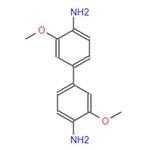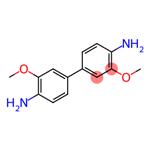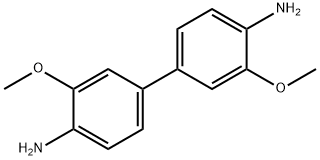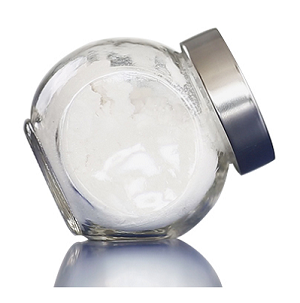- o-Dimethoxybenzidine
-

- $13.00 / 5g
-
2025-10-14
- CAS:119-90-4
- Min. Order: 5g
- Purity: 0.98
- Supply Ability: 100kg
- o-Dianisidine
-

- $0.00 / 200kg
-
2025-08-25
- CAS:119-90-4
- Min. Order: 20kg
- Purity: 99%
- Supply Ability: 20 tons
- o-Dianisidine
-

- $1.00 / 1KG
-
2019-12-31
- CAS:119-90-4
- Min. Order: 1KG
- Purity: 95-99%
- Supply Ability: 1ton
|
| | o-Dianisidine Basic information |
| Product Name: | o-Dianisidine | | Synonyms: | o-Dianisidine,3,3′-Dimethoxybenzidine, Fast BlueB;3.3'-Dimethoxybenzidine 1g [119-90-4];4,4'-Diamino-3,3'-dimethoxybiphenyl
3,3'-Dimethoxybenzidine
Fast Blue B;3.3'-DiMethoxy;3,3'-Dimethoxybenzidine Solution, 100ppm;[1,1'-Biphenyl]-4,4'-diamine, 3,3'-dimethoxy-;1’-biphenyl)-4,4’-diamine,3,3’-dimethoxy-(;1’-Biphenyl)-4,4’-diamine,3,3’-dimethoxy-(1 | | CAS: | 119-90-4 | | MF: | C14H16N2O2 | | MW: | 244.29 | | EINECS: | 204-355-4 | | Product Categories: | Intermediates of Dyes and Pigments;Biphenyl & Diphenyl ether | | Mol File: | 119-90-4.mol |  |
| | o-Dianisidine Chemical Properties |
| Melting point | 137-138 °C(lit.) | | Boiling point | 387.21°C (rough estimate) | | density | 1.1079 (rough estimate) | | refractive index | 1.6000 (estimate) | | Fp | 403 °F | | storage temp. | Store at RT. | | solubility | H2O: slightly soluble | | pka | 4.71±0.10(Predicted) | | Colour Index | 37235 | | form | Crystalline Powder | | color | Pink to beige-brown | | Water Solubility | Soluble in alcohol, benzene, ether, chloroform, acetone, most organic solvents and lipids. Slightly soluble in water. | | Merck | 14,2991 | | BRN | 1879884 | | CAS DataBase Reference | 119-90-4(CAS DataBase Reference) | | IARC | 2B (Vol. 4, Sup 7) 1987 | | NIST Chemistry Reference | Benzidine, 3,3'-dimethoxy-(119-90-4) | | EPA Substance Registry System | 3,3'-Dimethoxybenzidine (119-90-4) |
| Hazard Codes | T | | Risk Statements | 45-22 | | Safety Statements | 53-45 | | RIDADR | 2811 | | WGK Germany | 3 | | RTECS | DD0875000 | | TSCA | Yes | | HazardClass | 6.1(a) | | PackingGroup | II | | HS Code | 29222990 | | Hazardous Substances Data | 119-90-4(Hazardous Substances Data) | | Toxicity | Dianisidine is a probable
carcinogen used in the manufacture of dyes. EPA has classified
as a Group 2B—probable human carcinogen. |
| | o-Dianisidine Usage And Synthesis |
| Description | DMOB is a colorless crystalline materialwhich may turn purple on standing in air. Molecularweight=244.32; Freezing/Melting point=137-138℃;Flash point=206℃. Hazard Identification (based onNFPA-704 M Rating System): Health 2, Flammability 1,Reactivity 0. Slightly soluble in water. | | Chemical Properties | o-Dianisidine, crystallizes dimorphically, rarely in needles, with mp 133°C , often in flakes with mp 137-138°C . It forms colorless crystals, but commercial products have a tinge of violet. It is sparingly soluble in water but soluble in alcohol, ether, and benzene. One gram of ethyl acetate dissolves 0.285 g of o-dianisidine at 73°C .

The pure compound is stable upon exposure to air, but commercial products turn violet. o-Dianisidine is resistant to water but sensitive to oxidizing agents. | | Uses | o-Dianisidine is a starting material for the production of disazo dyes and pigments.
Like benzidine and o-tolidine, o-dianisidine forms colors with numerous oxidizing agents, e.g., copper, cobalt, and gold ions. o-Dianisidine is quantitatively determined by titration with nitrite using potassium iodide and starch paper as the indicator. o-Dianisidine can be detected in the urine using potassium 1,2-naphthoquinone4-sulfonate after extraction. A rapid and easy method is based on the color formed with cyanogen bromide. Its detection limit is 0.05 mg/kg.
The free o-dianisidine base and the dihydrochloride are marketed in moist forms with a 10-30% water content. | | Uses | o-Dianisidine is used as a redox indicator. It is used as an intermediate for the preparation of azo dyes, pigments and o-dianisidine diisocyanate, which finds application in adhesives, polyurethane elastomers and resins. It is also used in various industries like leather, paper, plastics, rubber, and textiles. It acts as a reagent to detect metals, thiocyanates, and nitrites. | | Uses | o-Dianisidine is used almost exclusively as a chemical intermediate for producing dyes and pigments. In 1971, the Society of Dyers and Colourists reported its use in the production of 89 dyes (see Dyes Metabolized to o-Dianisidine, below). o-Dianisidine is also used as a chemical intermediate to produce o-dianisidine diisocyanate for use in adhesives and as a component of polyurethanes. Other uses are as a dye for paper, plastics, rubber, and textiles and as a test substance for detection of metals, thiocyanates, and nitrites (IARC 1974, HSDB 2009). | | Preparation | 2-Nitroanisole is reduced (H2-catalyst or iron-formic acid) to o-anisidine or (benzidine-type reaction) to o-dianisidine [119-90-4], both of which are important as dye intermediates. | | Definition | ChEBI: 3,3'-Dimethoxybenzidine is a member of biphenyls. | | Synthesis Reference(s) | Journal of the American Chemical Society, 106, p. 7077, 1984 DOI: 10.1021/ja00335a035 | | General Description | Colorless crystals or a light brown powder. Turns violet on standing. Carcinogen. | | Air & Water Reactions | Finely powdered material is a significant dust explosion hazard. Insoluble in water. | | Reactivity Profile | o-Dianisidine is a weak base. Reacts exothermically with acids. Sensitive to heat, air and prolonged exposure to light. | | Fire Hazard | o-Dianisidine is combustible. | | Safety Profile | Confirmed carcinogen
with experimental tumorigenic data.
Moderately toxic by ingestion. Mutation data
reported. Combustible when exposed to
heat or flame. When heated to
decomposition it emits toxic fumes of NOx. | | Toxicology | In the presence of rat liver homogenate, o- dianisidine is positive in the Ames test. It is capable of inducing unscheduled DNA synthesis inHeLa cells and in primary rat hepatocytes, and it provokes cell transformation in baby hamster kidney cells in vitro. o-Dianisidine is carcinogenic in rats. An oral dose of 30 mg administered three times per week for 13 months produced tumors in the zymbal glands and in other tissues. No conclusive epidemiological studies have been reported on the carcinogenicity of o-diani- sidine in humans. No MAK value has been established. o-Dianisidine is classified in group III B.
| | Potential Exposure | Tumorigen,Mutagen; Human Data. DMOB or its dihydrochloride isused principally as a chemical intermediate for the production of azo dyes. About 30% of DMOB is used as a chemical intermediate in the production of o-dianisidinediisocyanate (3,30-dimethoxy-4,40-diisocyanate-biphenyl)that is used in adhesive systems and also as a component ofpolyurethane elastomers and resins. DMOB is used as a dyeitself for leather, paper, plastics, rubber, and textiles.DMOB has also been used in the detection of metals, thiocyanates, and nitrites. | | First aid | If this chemical gets into the eyes, remove anycontact lenses at once and irrigate immediately for at least15 min, occasionally lifting upper and lower lids. Seekmedical attention immediately. If this chemical contactsthe skin, remove contaminated clothing and wash immediately with soap and water. Seek medical attention immediately. If this chemical has been inhaled, remove fromexposure, begin rescue breathing (using universal precautions, including resuscitation mask) if breathing hasstopped and CPR if heart action has stopped. Transferpromptly to a medical facility. When this chemical hasbeen swallowed, get medical attention. Give large quantities of water and induce vomiting. Do not make an unconscious person vomit. | | Carcinogenicity | o-Dianisidine is reasonably anticipated to be a human carcinogen based on sufficient evidence of carcinogenicity from studies in experimental animals. | | storage | Color Code—Blue: Health Hazard/Poison: Storein a secure poison location. 3,30-Dimethoxybenzidine mayreact with oxidizers (such as perchlorates, peroxides, permanganates, chlorates, and nitrates). Store in tightly closedcontainers in a cool, well-ventilated area. Avoid exposureto light. A regulated, marked area should be establishedwhere this chemical is handled, used, or stored in compliance with OSHA Standard 1910.1045. | | Shipping | Dyes, liquid, toxic, n.o.s or Dye intermediates,liquid, toxic, n.o.s. require a label of “POISONOUS/TOXICMATERIALS.” They fall in Hazard Class 6.1 and 3,30-dimethoxybenzidine in Packing Group II. | | Properties and Applications | red light navy blue light to dark. And C.I.Azoic Diazo Component 48 the same chemical structure.
|
Standard(Polyamide)
|
Ironing Fastness
|
Light Fastness
|
Persperation Fastness
|
Washing Fastness
|
|
Fading
|
Stain
|
Fading
|
Stain
|
Fading
|
Stain
|
|
AATCC
|
|
|
2
|
5
|
5
|
5
|
5
|
| | Incompatibilities | Oxidizers. | | Toxics Screening Level | The initial threshold screening level (ITSL) for 3,3’-dimethoxybenzidine (CAS# 119-90-4) is 9.8 μg/m3 based on an annual averaging time. |
| | o-Dianisidine Preparation Products And Raw materials |
| Raw materials | 2-Nitroanisole-->o-Dianisidine | | Preparation Products | 3,3'-Dihydroxybenzidine-->Direct Blue 151-->disodium 3-[[4'-[[6-amino-1-hydroxy-3-sulphonato-2-naphthyl]azo]-3,3'-dimethoxy[1,1'-biphenyl]-4-yl]azo]-4-hydroxynaphthalene-1-sulphonate-->CHICAGO SKY BLUE 6B-->3,3'-dihydroxy-[1,1'-biphenyl]-4,4'-dicarboxylic acid-->BENZOAZURINE-->1-Naphthalenesulfonic acid, 4-amino-5-hydroxy-6-[[4'-[(4-hydroxyphenyl)azo]-3,3'-dimethoxy[1,1'-biphenyl]-4-yl]azo]-, monosodium salt-->1,6-Naphthalenedisulfonic acid, 7-[[4'-[(6-amino-1-hydroxy-3-sulfo-2-naphthalenyl)azo]-3,3'-dimethoxy[1,1'-biphenyl]-4-yl]azo]-8-hydroxy-, trisodium salt-->tetrasodium [mu-[[3,3'-[(3,3'-dihydroxy[1,1'-biphenyl]-4,4'-diyl)bis(azo)]bis[4,5-dihydroxynaphthalene-2,7-disulphonato]](8-)]]dicuprate(4-)-->C.I. Direct Black 87-->CHICAGO SKY BLUE 6B-->DIRECTVIOLET32-->2,7-Naphthalenedisulfonic acid, 3,3'-[(3,3'-dimethoxy[1,1'-biphenyl]-4,4'-diyl)bis(azo)]bis[5-chloro-4-hydroxy-, tetrasodium salt-->1-Naphthalenesulfonic acid, 3-[[4'-[(2,4-diamino-5-methylphenyl)azo]-3,3'-dimethoxy[1,1'-biphenyl]-4-yl]azo]-4,6-dihydroxy-, monosodium salt-->2-Naphthalenesulfonic acid, 6-amino-3-[[4'-[(4-amino-6-sulfo-1-naphthalenyl)azo]-3,3'-dimethoxy[1,1'-biphenyl]-4-yl]azo]-4-hydroxy-, disodium salt-->DIRECT BLACK 91-->Direct Blue 151-->DIRECT BLUE 98-->Direct blue 215 (C.I. 24415)-->DIRECT BLUE 80 |
|